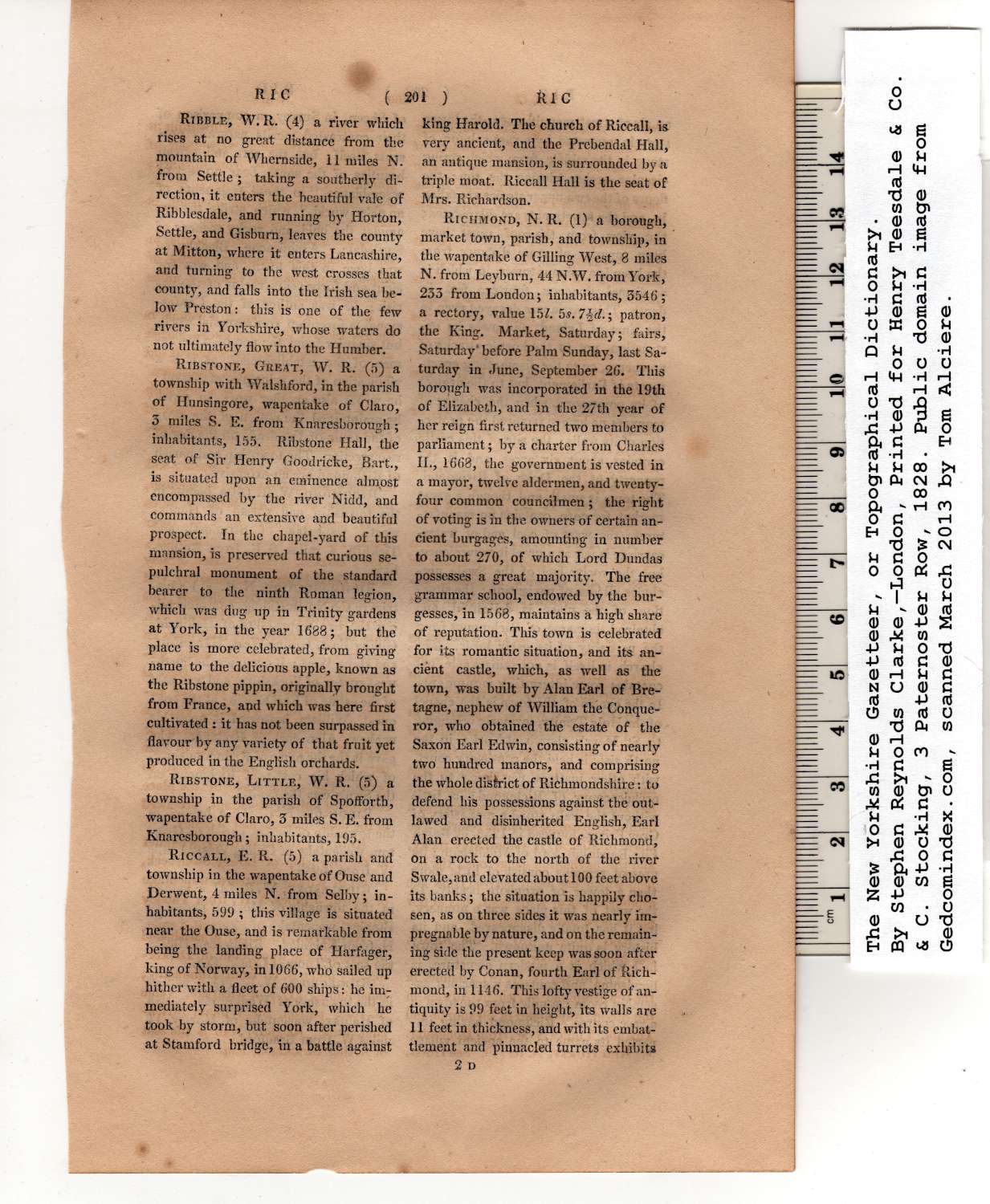|
Ribble, W. R. (4) a river which
rises at no great distance from the
mountain of Whernside, II miles N.
from Settle ; taking a southerly di-
rection, it enters the beautiful vale of
Ribblesdale, and running by Horton,
Settle, and Gisburn, leaves the county
at Mitton, where it' enters Lancashire,
and turning to the west crosses that
county, and falls into the Irish sea be-
low Preston: this is one of the few
rivers in Yorkshire, whose waters do
not ultimately flow into the Humber.
Ribstone, Great, W. R. (5) a
township with Walshford, in the parish
of Hunsingore, wapentake of Claro,
3 miles S. E. from Knaresborough;
inhabitants, 155. Ribstone Hall, the
seat of Sir Henry Goodricke, Bart.,
is situated upon an eminence almost
encompassed by the river Nidd, and
commands an extensive and beautiful
prospect. In the chapel-yard of this
mansion, is preserved that curious se-
pulchral monument of the standard
bearer to the ninth Roman legion,
which wTas dug up in Trinity gardens
at York, in the year 1688; but the
place is more celebrated, from giving
name to the delicious apple, known as
the Ribstone pippin, originally brought
from France, and which was here first
cultivated : it has not been surpassed in
flavour by any variety of that fruit yet
produced in the English orchards.
Ribstone, Little, W. R. (5) a
township in the parish of Spofforth,
wapentake of Claro, 3 miles S. E. from
Knaresborough; inhabitants, 195.
Riccall, E. R. (5) a parish and
township in the wapentake of Ouse and
Derwent, 4 miles N. from Selby; in-
habitants, 599 ; this village is situated
near the Ouse, and is remarkable from
being the landing place of Harfager,
king of Norway, in 1066, who sailed up
hither with a fleet of 600 ships: he imp
mediately surprised York, which he
took by storm, but soon after perished
at Stamford bridge, in a battle against
king Harold. The church of Riccall, is
very ancient, and the Prebendal Hall,
an antique mansion, is surrounded by a
triple moat. Riccall Hall is the seat of
Mrs. Richardson. |
Richmond, N. R. (1) a borough,
market town, parish, and township, in
the wapentake of Gilling West, 8 miles
N. from Leyburn, 44 N.W. from York,
233 from London; inhabitants, 3546;
a rectory, value 15/. 5s. 7^d.; patron,
the King. Market, Saturday; fairs,
Saturday" before Palm Sunday, last Sa-
turday in June, September 26. This
borough was incorporated in the 19th
of Elizabeth, and in the 27th year of
her reign first returned two members to
parliament; by a charter from Charles
II., 1668, the government is vested in
a mayor, twelve aldermen, and twenty-
four common councilmen; the right
of voting is in the owners of certain an-
cient burgages, amounting in number
to about 270, of which Lord Dundas
possesses a great majority. The free
grammar school, endowed by the bur-
gesses, in 1568, maintains a high share
of reputation. This town is celebrated
for its romantic situation, and its an-
cient castle, which, as well as the
town, was built by Alan Earl of Bre-
tagne, nephew of William the Conque-
ror, who obtained the estate of the
Saxon Earl Edwin, consisting of nearly
two hundred manors, and comprising
the whole district of Richmondshire: to
defend his possessions against the out-
lawed and disinherited English, Earl
Alan erected the castle of Richmond,
on a rock to the north of the river
Swale, and elevated about 100 feet above
its banks; the situation is happily cho-
sen, as on three sides it was nearly im-
pregnable by nature, and on the remain-
ing side the present keep was soon after
erected by Conan, fourth Earl of Rich-
mond, in 1146. This lofty vestige of an-
tiquity is 99 feet in height, its walls are
11 feet in thickness, and with its embat-
tlement and pinnacled turrets exhibits
2 D |
